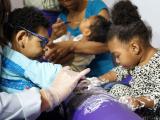Scientists today unveiled a second Zika mouse model for studying drugs and vaccines, while a separate group recommended screening tests for all pregnant women who may have been exposed to the virus.
Scientists are eager to untangle the many mysteries surrounding the virus, not only to flesh out the connection between the virus and birth defects, but also to fast-forward work on countermeasures.
In other developments, another research team raised new questions about how Zika virus crosses the placenta, Vietnam reported is first two local cases, and confirmed cases in Mexico passed the 200 mark.
Mouse infections show some human parallels
The mouse model study, led by a research team at Washington University School of Medicine, suggested some intriguing parallels to patterns seen in fetal and human infections. The group published its findings today in Cell Host & Microbe.
The study comes close on the heels of a Mar 28 report of the first mouse model for studying Zika virus since the 1970s, from researchers at the University of Texas Medical Branch.
Mice aren't easily infected with Zika virus, so, as with the earlier study, Washington University researchers used mice that were genetically modified to impair immune response to the virus. The mice in the latest study couldn't produce the crucial signaling molecule interferon, which reduced their immune response.
Researchers tested five Zika strains in the mice, the original strain collected in 1947 in Uganda, three that circulated in Senegal in the 1980s, and the strain responsible for French Polynesia's outbreak in 2013, which is closely related to the Asian strain circulating in the Americas. Tests are under way with the current outbreak strain.
Mice infected with the different strains showed similar results, which hints that the viruses may not vary much by pathogenicity, the team reported.
Michael Diamond, MD, PhD, senior author and professor of medicine at Washington University, said in a press release from the school that the virus replicated well in the immune-deficient mice and went to anatomic sites that seem similar to patterns seen in humans.
When infected with Zika, immune-deficient mice lost weight, became lethargic, and died within 10 days of inoculation. In the part of the study using normal mice, however, the animals developed severe symptoms only if they were infected within 1 week of birth, before their immune systems developed, similar to what experts have observed in humans.
"It appears that pregnant women infected with Zika can pass the virus to babies in utero and that newborns also may be susceptible to infection," Diamond said. "Other than in infants, we don't really see severe disease in most people with Zika, except for a small fraction who develop Guillain-Barre [syndrome]."
As an added study step, the researchers examined mouse testes for Zika virus and found that viral levels were higher there than in any other tissue. Diamond said follow-up tests are under way to see how long the viral levels are sustained, which might help determine how long the virus can transmit sexually.
Zika pregnancy screening algorithm
Meanwhile, a group of perinatal and infectious disease specialists from Europe and French Polynesia yesterday proposed that all pregnant women who had potential exposure to Zika virus be screened, given that 80% of people infected are said to be asymptomatic. The experts offered a detailed algorithm to help clinicians monitor patients.
The group's report appears in the latest online edition of Lancet Infectious Diseases. They noted that although the connection between Zika virus and birth defects hasn't been definitively confirmed yet, the evidence so far is alarming.
They acknowledged difficulties with testing and symptom-timing assessments and suggested that sampling saliva and urine might help detect Zika during the acute phase.
Asymptomatic newborns should be closely monitored for latent abnormalities, they said, adding that alternative diagnoses should be considered for those with birth defects.
Placental crossing, cases in Vietnam, Mexico
- In other research news, lab tests suggest Zika virus evades cells in the placenta (primary human trophoblasts, or PHTs) that protect the fetus or use other strategies to cross the placental barrier, researchers from Pennsylvania and Brazil reported today in Cell Host & Microbe. Their tests involved replicating both Asian and African Zika virus strains in PHTs isolated from healthy term placentas.
- Vietnam's health ministry yesterday announced its first two local Zika virus detections, according to a report today from Viet Nam News. The patients are women, ages 64 and 33. One is from Kahnh Hoa province, in the central part of the country, and the younger woman—who is in her second trimester of pregnancy—is from Ho Chi Minh City in southern Vietnam. The country had recently raised a Zika alert after an Australian tourist got sick after visiting several Vietnamese cities.
- Mexico has now confirmed 201 Zika infections, 181 in the southern states of Chiapas and Oaxaca, Xinhua News reported today, citing a weekly update yesterday from the country's health ministry. Of the confirmed cases, 48 are in pregnant women who live in Chiapas, Oaxaca, and Veracruz states.
See also:
Apr 5 Cell Host Microbe study
Apr 5 Washington University School of Medicine press release
Apr 4 Lancet Infect Dis abstract
Mar 28 CIDRAP News story "New mouse model paves way for Zika drug, vaccine tests"





















